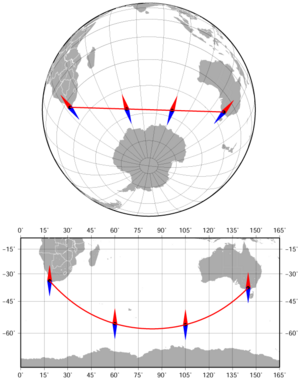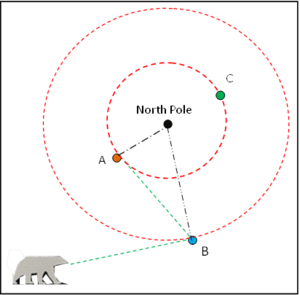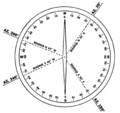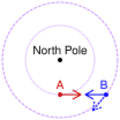Bearing (angle) facts for kids
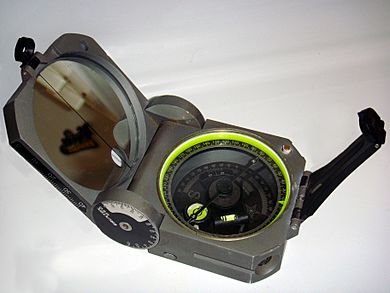
In navigation, a bearing is a way to describe the direction of something. Think of it as an angle that tells you where an object is compared to a known direction, like north or the direction you are facing. This angle is usually measured in degrees.
There are two main types of bearings:
- Absolute bearing is the angle measured from north (either true north or magnetic north) to an object. For example, if something is exactly to your east, its absolute bearing would be 90 degrees from north. This is also known as an azimuth.
- Relative bearing is the angle measured from the direction you are currently moving (your heading) to an object. For instance, if an object is directly in front of you, its relative bearing is 0 degrees. If it's directly behind you, it's 180 degrees.
Contents
Types of Bearings
Absolute Bearing
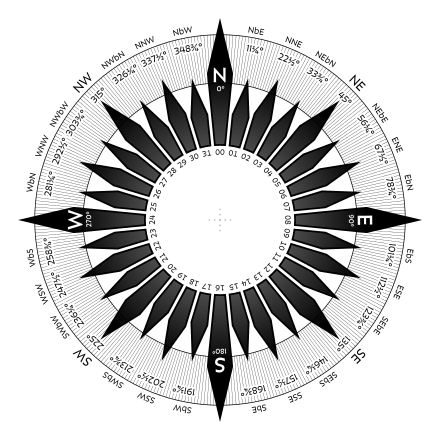
An absolute bearing tells you the direction of an object from north. Imagine you're standing still and looking at a compass.
- If you use the true geographical North Pole as your reference, it's called a true bearing.
- If you use the magnetic north (where your compass needle points), it's called a magnetic bearing.
Sailors and explorers use absolute bearings to figure out where they are on a nautical chart (a special map for the sea). By measuring the bearing to a known landmark, they can draw lines on the map to find their exact location.
Sometimes, maps use a "grid north" which is based on the straight lines on the map itself. This gives you a grid bearing. Also, the compass on a vehicle or ship might be slightly off due to metal parts. The reading from that compass is a compass bearing, which is usually very close to the magnetic bearing.
Relative Bearing
When you're moving, like on a ship or in a car, a relative bearing tells you the direction of an object compared to the way your vehicle is pointing. It's measured clockwise from your vehicle's front.
Sailors use special tools like a pelorus to measure relative bearings. This information helps them understand:
- Their own position, speed, and direction.
- If they are on a collision course with another vessel.
For example:
- If a ship sees a lighthouse at a relative bearing of 45 degrees, and later at 90 degrees, they can calculate how far they traveled and how far they are from the lighthouse.
- If the relative bearing to another boat stays the same, it means both boats are heading towards each other, and there's a risk of collision!
How Bearings are Used
Bearings are super useful in many situations:
- Piloting: If two ships are moving towards each other and the relative bearing between them doesn't change, they are likely to crash. One or both ships need to change course to avoid a collision.
- Search and Rescue: If someone is in trouble, a bearing can be taken to their location. This helps rescuers go directly to them.
- Land Navigation: When hiking or exploring, a bearing helps you find your way. It's usually measured clockwise from north, from 0 to 359.9 degrees.
- Aircraft Navigation: Pilots use relative bearings to find targets or other aircraft. The angle is measured from the aircraft's direction of travel.
- Marine Navigation (Old Methods): In the past, sailors used "points" of a compass. A full circle was divided into 32 points, each 11.25 degrees. So, an object "two points off the starboard bow" meant it was a certain angle to the front-right of the ship.
- Clock Method: An easy way to give a relative bearing is using the "clock method." Imagine a clock face on your vehicle, with 12 o'clock pointing forward. An object directly to your right is at "three o'clock," and something behind you is at "six o'clock."
- Land Surveying: Surveyors use bearings to map land. They might record directions like "N57°E" (North 57 degrees East), meaning 57 degrees east of north.
- Satellite Broadcasting: For satellite dishes, a bearing is the combination of the horizontal angle (azimuth) and the vertical angle (elevation) needed to point the dish at a satellite.
Bearings and Curved Paths
When you travel a very long distance on Earth, like across an ocean, the shortest path isn't a straight line on a flat map. It's a curve called a great circle.
- If you follow a great circle, your bearing (the direction you are facing) will actually change as you move.
- For example, if you travel from one point to another on the same line of latitude (like going straight east or west), you have to keep adjusting your direction slightly to stay on that latitude line. Only at the Equator can you go perfectly east or west and stay on a "straight" path without changing your bearing.
Images for kids
-
A and B are near the North Pole and facing each other. Though A is facing east, B is not facing west. If B were to face west, her direction (dashed arrow) would be tangential to her latitude circle (dashed circle). Only on the equator is it true that if A faces east and B faces west that they can face each other.
See also
 In Spanish: Rumbo para niños
In Spanish: Rumbo para niños
- Cardinal direction
- Constant bearing, decreasing range
- Course (navigation)
- Heading (navigation)


